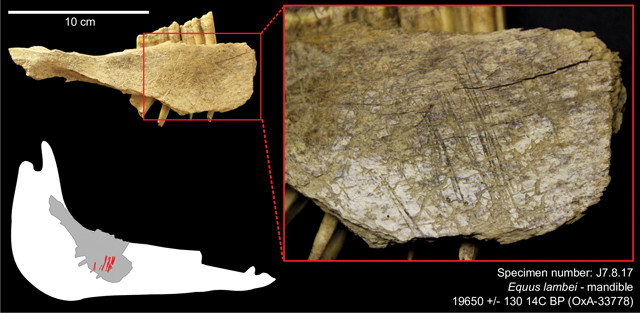
by Mary Caperton Morton Wednesday, April 19, 2017

Dating of this horse mandible from the Bluefish Caves in the Yukon suggests humans were at the site as early as 24,000 years ago. Credit: Bourgeon et al., PLOS ONE, January 2017, CC BY 4.0.
New dating of artifacts recovered from a site in the northern Yukon, on the Alaskan border, may push back the hypothesized entry date of the first American colonizers via a northwestern route — long thought to have occurred over the Bering land bridge between 18,000 and 14,000 years ago — by several thousand years.
When artifacts from the Bluefish Caves in the northern Yukon were first radiocarbon dated after their discovery in the 1970s, the results suggested that people may have used the caves as early as 30,000 years ago, making it much older than any other archaeological site in North America — a find that led many researchers to question its validity. New radiocarbon dating of a fragment from a horse mandible, reported in PLOS ONE, points to a more recent date between 23,000 and 24,000 years ago, but reconfirms the relatively early nature of the site.
The mandible is one of 36,000 bone fragments recovered from the cave in the 1970s and 1980s. Previously, few clues connected the bones to the presence of humans, but lead author Lauriane Bourgeon of the University of Montreal combed through the collection for more than two years, looking for marks that could have been left by people. She found “undeniable” traces of human activity on 15 bones, with another 20 or so fragments showing “probable” traces. The telltale markings included a “series of straight, V-shaped lines on the surface of the bones made by stone tools used to skin animals. These are indisputable cut-marks created by humans,” said co-author Ariane Burke, also of the University of Montreal, in a statement.
The new work “demonstrates that this is the earliest-known site of human settlement in Canada,” Burke said. The find may also lend support to the Beringia Standstill Hypothesis, which holds that people living in this region were isolated for a significant period of time during the last glacial maximum when the area was cut off from the rest of North America by glaciers.
© 2008-2021. All rights reserved. Any copying, redistribution or retransmission of any of the contents of this service without the expressed written permission of the American Geosciences Institute is expressly prohibited. Click here for all copyright requests.